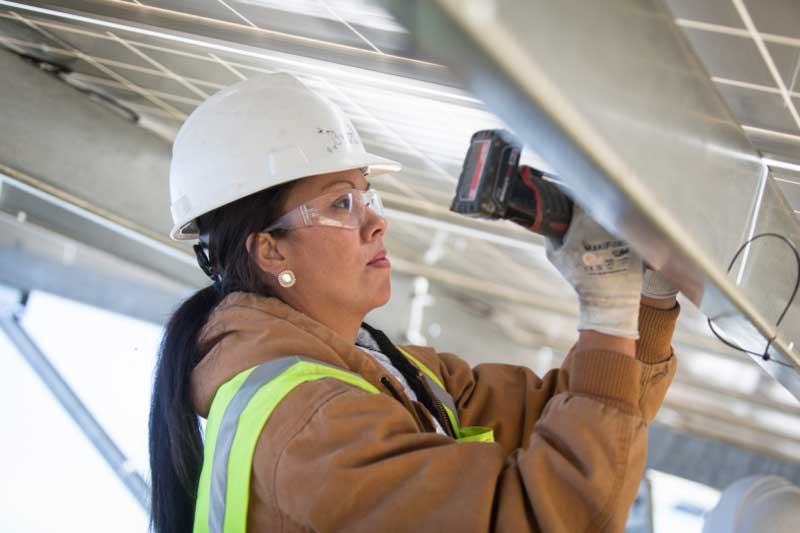The solar energy technology market has grown very rapidly in recent years, mostly driven by technological improvements that reduced costs and government policies supportive of renewable energy. However, solar energy still is more expensive than conventional energy-resources despite rapidly declining costs, and thus, sustained policy support is needed, so that its growth will continue.
The right mix of policy towards solar energy development should arise from the hidden benefits of solar energy, and go beyond the achievement of parity in grid costs. The United States Department of Energy (DOE) is providing strong coordination through its SunShot Initiative, focusing on direct cost reduction.
Launched in 2011, the initiative aims to lower the price of solar energy systems by about 75 percent between 2010 and 2020. Meeting this target is expected to make the unsubsidized cost of solar energy competitive with that of other currently operating energy sources, so paving the way for the rapid, largescale adoption of solar electricity across the United States.

American solar power continued its rapid growth in 2015, adding new jobs 12 times faster than the rest of the economy, while saving customers tens of millions of dollars per year on energy bills. | Photo courtesy of O2emc.
How policy hinders the penetration of solar energy technologies
The need to enact policy in support of solar energy technologies is often attributed to a variety of barriers preventing investments in the sector. These said barriers put the solar energy sector at an economic, regulatory and institutional disadvantage compared to other sources of producing energy.
Most of these barriers act as market distortions that unfairly discriminate against the implementation of solar energy technologies. There are a few points to note on how negative policy hinders the penetration and wide adoption of solar energy technologies in the United States.
1. Costs
Public subsidies may lower the costs of competing sources of energy production such as subsidies on fossil fuel sources, examples being oil or coal. The United States government continuously attempts to compensate for cost related barriers to solar energy adoption by providing subsidies in the form of tax credits or other incentives.
By setting special pricing or by lowering some transactional costs involved in the implementation of solar energy technology.
These practical policies focus on increasing subsidies for solar energy technologies rather than reducing or removing the many subsidies for fossil fuels and other competing sources for producing energy.
Although these are all positive steps towards supporting solar energy implementation in the United States, many pundits say that unless policies in support of programs that subsidize fossil fuel technologies are stopped, the solar energy sector will continue to face difficult challenges that help its adoption in the United States.
2. Legal
The current legal and regulatory schemes make it difficult for private project developers to properly invest in solar energy technologies.
Most utilities control the monopoly on electricity production and distribution, so independent power producers can’t just plan and finance projects that produce power for sale to the utility or third parties under most power purchase agreements.
There are also other restrictions on siting and construction, transmission access issues, complicated utility interconnection regulatory frameworks and an endless slew of liability insurance requirements involved in installing and using small power generators for islanding projects.
Liability is a major issue when it comes to solar energy technology projects and the relationship it has to net metering and other statutes.
3. Market
A huge setback to the wide implementation of solar energy technologies is the lack of access to credit due to the lack of quality collateral, poor creditworthiness or in some cases the capital market could simply be distorted.
Although most solar energy technologies are invented or developed in the United States, most manufacturing is done abroad. This is a common trend with manufacturing today, due to international trade policies the United States has with many foreign countries, manufacturing makes more sense to companies being aboard than in the continental United States.
Thus the United States job market and companies are at a disadvantage when competing with other fossil fuel companies. On another hand, protectionist policies like local content requirements and high tariffs limit demand for products imported from the United States into markets abroad—countries like India, South Africa, Brazil, and Saudi Arabia have all used some form of policy to limit opportunities for foreign manufacturers to compete in their markets.
A Perspective
The United States’ economic and environmental well-being depends on a strong shift toward electricity generated with fuels that are abundant and reliable, and have a relatively clean environmental footprint. Solar energy technologies present a viable opportunity to achieve this potential.
Latest trends and reports indicate that solar energy technology is experiencing significant growth in the United States.
The latest GTM Research U.S. Solar Market Insight estimates that the country installed 1,393 megawatts of solar photovoltaics in the second quarter of 2015 to reach 22.7 gigawatts of total installed capacity. That’s enough energy to power 4.6 million American homes.
A recently released IHS report on the Top Solar Power Industry Trends for 2015 concludes that a strengthening recovery of the solar industry in 2015 is inevitable.
The report also cautioned that positive policy in support of the solar energy technology sector will continue to be key—if we are to attain solar energy’s full potential in the near future.
Keywords: Solar Energy, Policy, United States















Comments